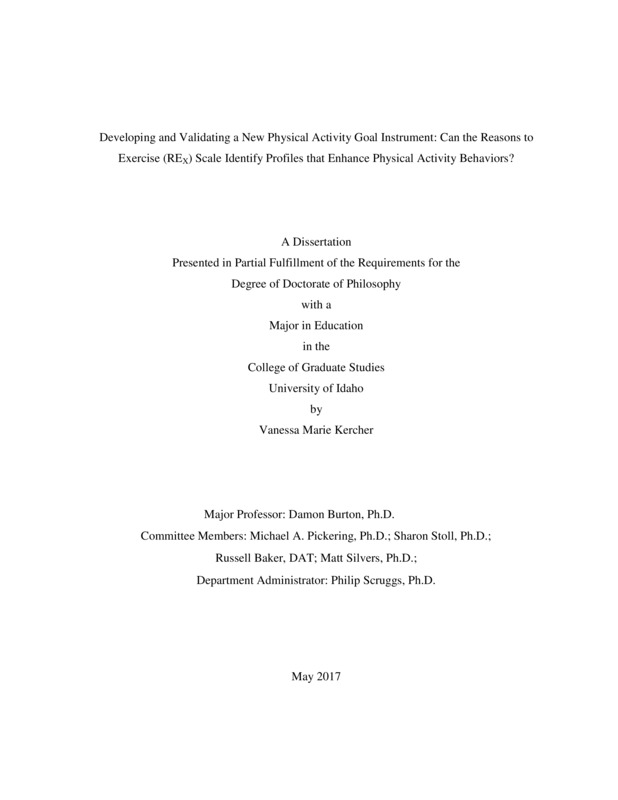Developing and Validating a New Physical Activity Goal Instrument: Can the Reasons to Exercise (REX) Scale Identify Profiles that Enhance Physical Activity Behaviors?
Kercher, Vanessa Marie. (2017). Developing and Validating a New Physical Activity Goal Instrument: Can the Reasons to Exercise (REX) Scale Identify Profiles that Enhance Physical Activity Behaviors?. Theses and Dissertations Collection, University of Idaho Library Digital Collections. https://www.lib.uidaho.edu/digital/etd/items/kercher_idaho_0089e_11071.html
- Title:
- Developing and Validating a New Physical Activity Goal Instrument: Can the Reasons to Exercise (REX) Scale Identify Profiles that Enhance Physical Activity Behaviors?
- Author:
- Kercher, Vanessa Marie
- Date:
- 2017
- Embargo Remove Date:
- 2017-12-12
- Keywords:
- Goals Motivation Physical Activity Reasons to Exercise
- Program:
- Movement & Leisure Sciences
- Subject Category:
- Behavioral sciences; Health sciences; Kinesiology
- Abstract:
-
Understanding what moves people to be physically active is key to identifying sources of motivation critical to promote engagement, persistence, and adherence in physical activity (PA) programs. Three separate, but related, studies were conducted to develop and validate comprehensive PA goal measure, the Reasons to Exercise (REX) Scale, and establish it as a viable measurement of reasons people have for exercising and/or being physically active. Study 1 developed the final REX Scale item pool. Initial evidence suggested the REX Scale was a valid and reliable measure, although additional work will need to be done to refine the instrument. Examination of the REX revealed nine latent factors held up under both the unrestricted (i.e., exploratory factor analyses) and restricted (i.e., covariance modeling), and based on Cronbach’s alpha, the items within each hypothesized dimension were similar and closely related. Following the development of the REX, Study 2 assessed the psychometric properties of the Reasons to Exercise-Version 2 (REX-2) in another sample of active adults. A nine-factor, 36-item instrument demonstrated the REX-2 as a useful tool for measuring the reasons people have for exercising in two sample of adults. The multi-group CFAs for gender and age provided reasonable evidence of measurement and structural invariance using the difference in CFI scores as the criterion. Finally, Study 3 examined how clusters created by cluster analysis using reason subscales and PA categories differed across behavioral regulation, passion, mindsets, and PA patterns. The REX-2 subscales were used to create four unique, meaningful reason profiles, and five PA profile groups were formed using PA subscales. Differences among the reason and PA profiles were supportive of model predictions. In the reason profiles, the number of valued reasons and individuals exhibiting more autonomous-focused reasons for being physically active led to more desirable outcomes that those with fewer valued exercise reasons or individuals exhibiting more control-focused reasons. In the PA profile findings, motivation was critical to PA engagement, and individuals engaging in higher-intensity type of physical activities were more autonomously motivated.
- Description:
- doctoral, Ph.D., Movement & Leisure Sciences -- University of Idaho - College of Graduate Studies, 2017
- Major Professor:
- Burton, Damon
- Committee:
- Pickering, Tony M; Stoll, Sharon; Baker, Rusty; Silvers, Matt
- Defense Date:
- 2017
- Identifier:
- Kercher_idaho_0089E_11071
- Type:
- Text
- Format Original:
- Format:
- application/pdf
- Rights:
- In Copyright - Educational Use Permitted. For more information, please contact University of Idaho Library Special Collections and Archives Department at libspec@uidaho.edu.
- Standardized Rights:
- http://rightsstatements.org/vocab/InC-EDU/1.0/

